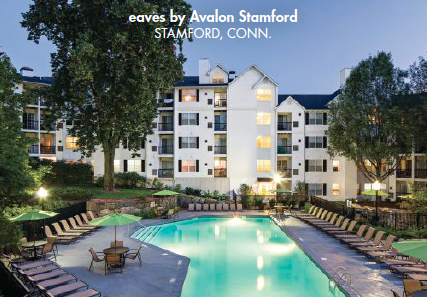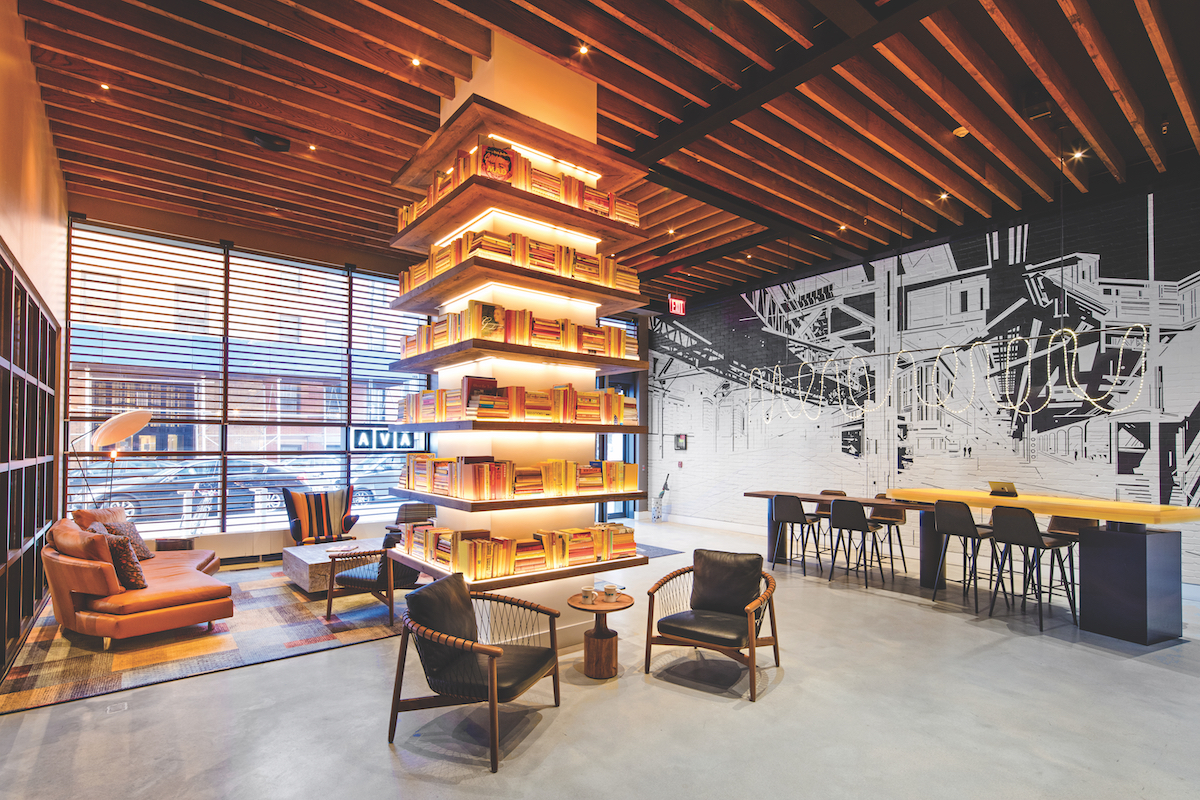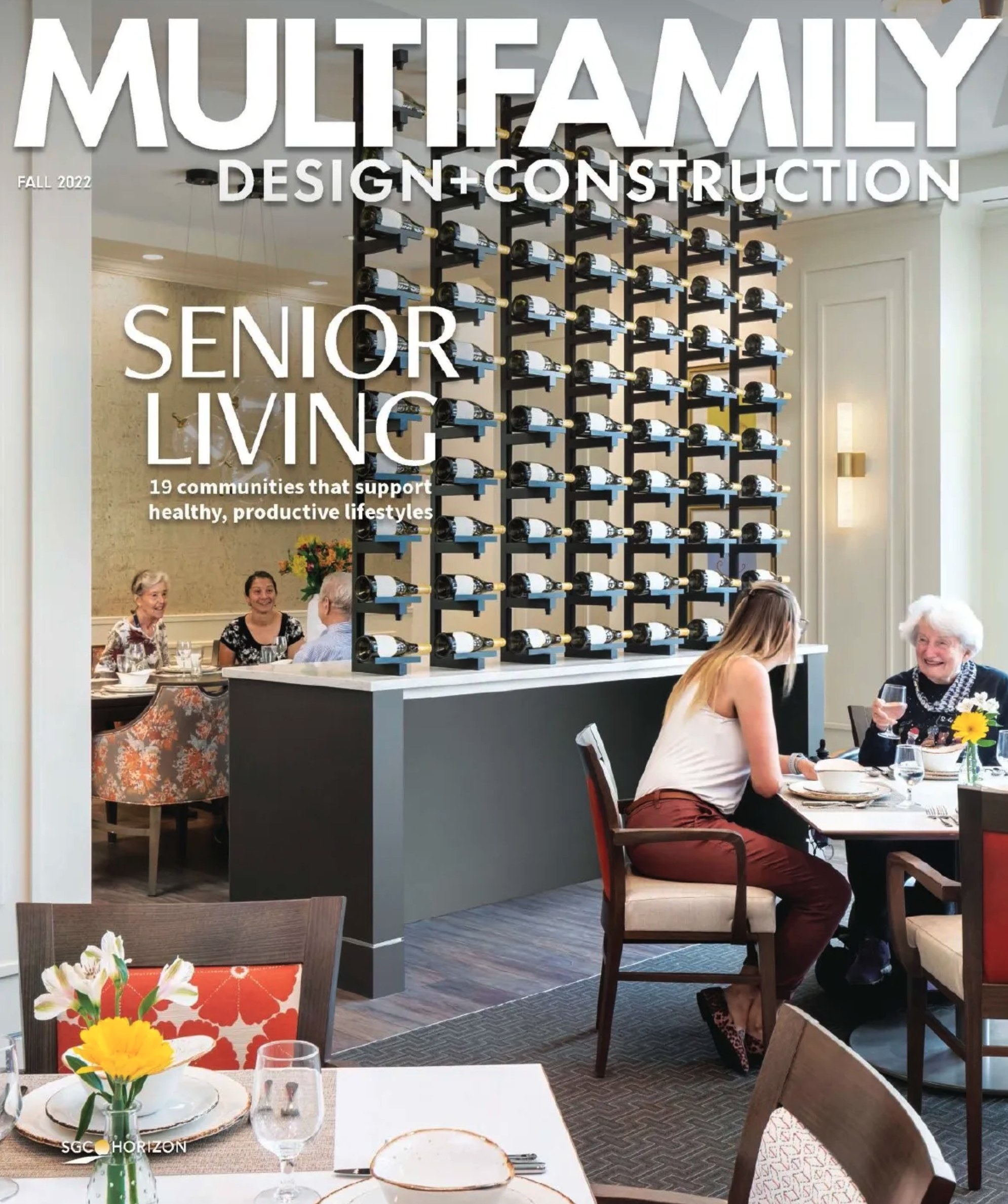AvalonBay Communities, the fourth-largest owner of apartments in the U.S., holds more than 85,000 apartments, in 291 communities. The publicly traded equity REIT traces its origins to 1978 and the formation of Bay Apartment Communities, which merged with Avalon Properties Inc. in 1998.
The developer/owner-operator is active in 11 states—California, Colorado, Connecticut, Florida, Maryland, Massachusetts, New York, Rhode Island, Texas, Virginia, and Washington—and the District of Columbia.
Critical to AvalonBay’s success is its single-minded focus on upgrading the residential experience, especially its attention to small design details that could easily be overlooked. To be responsive to evolving consumer tastes, AvalonBay surveys residents at move-in, mid-lease, and move-out to ask whether they would recommend AvalonBay, and why—or why not.
“We continue to grind away on unit layouts, not just on the eye candy,” said Jong Chung, AIA, Vice President of Design. “We’re engineering the space so it is seamless and painless for residents.”
That intense focus includes tweaking standards for the height of countertops, the placement of electrical outlets, and the positioning of doors—features that may not catch a prospective renter’s eye on a walkthrough, Chung acknowledges, but which make the space more livable and improve the odds of gaining and retaining residents.


DOING THINGS IN THREES
The company’s culture is rooted in three core values: “integrity,” “a spirit of caring,” and “a focus on continuous improvement.” Michael Feigin, EVP/Chief Construction Officer, who joined AvalonBay in 2014, said he found it “refreshing” to witness how fervently AvalonBay employees embraced these values. “I’ve worked in places where nobody knows the company’s core values,” he said.
The company offers three brands to meet the needs of its three target markets: Avalon, its high-end luxury option; AVA, which appeals to “youthful lifestyles”; and eaves by Avalon, its “value-oriented” choice.
AvalonBay’s business strategy is also three-pronged:
1. A decentralized development and centrally led, self-performing construction platform, where the 11 regional offices lead the charge locally. Strategic direction and administrative support services for development is provided by leadership on each coast; the construction wing gets its direction and support from national headquarters in Arlington.
2. Ongoing investment in its portfolio through redevelopment, remerchandising, and capital expenditure where there is an immediate maintenance need, or where there is a market-driven opportunity to reposition a community. (AvalonBay redevelops roughly 5% of its portfolio every year.)
3. Acquisition of existing assets to more deeply penetrate strategically targeted markets, as evidenced by its recent expansion into Southeast Florida and Denver.

AVALON – “Where discerning renters live comfortably”
- Newer, quiet community near shops, restaurants, entertainment
- Higher rent, “best for the money”
- Mostly 2BRs, then 1BRs; fewer studios
- Larger living spaces (10-15% larger units)
- Feature options
• Current Avalon standard
• Fine Living (upgraded kitchen, bath)
- Amenities: “aspirational bordering on luxury”
- Spa-like fitness center
- Dog park, pet wash station
- Discounts at lifestyle retailers
- Concierge/assistance services (select communities)
Photos: photos: left, Alan Schindler; center, Bill Horsman; right, Daniel Gaines
The company’s hold-and-operate strategy means that the design and construction teams must “futureproof” properties against changes in rental trends, said Chung. Amenities and unit designs have to be nimble, so that they can be easily remodeled as consumer tastes evolve. “We don’t want to just jump on the latest fad,” said Chung, citing iPod stations that were all the rage just a few years ago.
For example, AvalonBay has shifted its kitchens from the galley or U-shaped designs that were once common to a more open look; islands have been added to provide convenient working space. Recently, the company has been outfitting kitchens with islands that are not only in sync with accessibility standards but also can be easily removed should kitchen islands go the way of the wall-mounted can crusher.
MORE CONSISTENCY IN THE CONSTRUCTION PROCESS
Feigin spearheaded the formation of a national construction management team to support the company’s six regional construction groups. “This has allowed us to bring a level of consistency to the construction process that we didn’t have before,” he said. The company has standardized its technology on Oracle’s Primavera Unifier (which it has rebranded internally as “IBeam”) for project management and Asta for scheduling and estimating, and has gone nearly paperless on the jobsite. The new structure has also led to more national purchasing agreements that reap better deals with vendors.
This coordinated approach to design and construction has enabled greater sharing of ideas and strategies between regions, said Feigin. Last year, after the White House announced stiff tariffs on goods from China, AvalonBay’s procurement team reached out to its design and local construction teams for possible new sources of quartz countertops, which AvalonBay had been buying from China. In the end, said Feigin, the firm struck a deal with an American manufacturer for higher-quality quartz countertops at almost the same price as the Chinese product.
The headquarters-based national support team of designers and construction professionals produces a steady flow of new ideas and approaches. The design group covers architecture, interior design, and design resources, which conducts R&D on new products. Other headquarters designers develop unit prototypes and design standards that guide consultant architects as they flesh out early-stage skeletal designs for specific properties. Certain elements—the minimum size of a fitness center, for instance—must be applied universally. “This shortens the design process because the consultants don’t start with a blank piece of paper,” said Chung.

AVA – “For aspiring, urban-minded, youthful lifestyle” individuals
- Active day/night neighborhood close to public transit
- Highest rent (often split)
- Higher 2BR mix (often with roommates)
- Smaller, “engineered” living spaces
• Sliding or barn doors
• Wood-like vinyl flooring
• Gear wall (select units)
• Charging station
• Shower-only in 1BRs and studios
- “Energized, stylish, contemporary” community spaces
- “Energized” fitness center
- Indoor/outdoor chill space
- DIY apartment personalization program
- Technology-leveraged services
Photos: left to right, Sam Kittner, Mike Rixon, Brian Parks
While performance standards must be met, regional variations in wall and ceiling assemblies are occasionally permitted, said Chung. For example, Seattle’s ultra-tough seismic code requires walls to be able to withstand lateral shaking during a tremor. As a result, in Seattle, AvalonBay’s fairly prescriptive guidelines for sound attenuation in wall assemblies have been modified to conform to local seismic requirements.
Feigin acknowledged that lack of acoustic privacy has been a source of criticism for years in resident surveys. He said the company’s standards committee, composed of members representing operations, construction, design, asset management and development from several regions, has implemented standards that have steadily improved acoustics in its buildings. (About 80% of its projects under construction are wood-frame; the rest are steel or concrete superstructure.) Every new project undergoes testing by an acoustic consultant. “You can’t make the buildings perfectly soundproof, but complaints have diminished over time,” said Feigin.
ALSO SEE: Multifamily visionary: The life and work of architect David Baker
AvalonBay regional construction crews inspect workmanship on site to ensure that construction methods are up to the firm’s quality standards. The company hires building envelope consultants for every project, with particular attention to preventing damage from water intrusion. “That can be an expensive proposition,” said Feigin, so preventing it is well worth the consultants’ fees.
The company has also made significant improvements to fire safety protocols on its construction sites. In 2017, an early-morning fire destroyed nearly half the units of an unoccupied 235-apartment AvalonBay project under construction in Maplewood, N.J. The cause of the fire was later ruled “undetermined” by local authorities.

Eaves by Avalon – “For cost-conscious renters hoping for something more”
- Older, quiet, low-key community
- Lowest rent possible, “value seeking”
- Mix of 1BRs and 2BRs
- Moderate-size living spaces
- Feature options
• Basic kitchen/bath/finishes
• Upgraded cabinet faces, flooring, fixtures
- Basic extant amenities
- Clean, basic fitness center
- Dog run
- Pool, clubroom, BBQ optional
- Upgraded laundry room (where in-unit laundry not available)
- Available at some locations:
• Security deposit refund upon renewal
• Two-year lease/rate lock
• “eavesextras” discounts/rewards
Photo: Alan Schindler
Company officials vowed to rebuild the complex and implemented stringent new rules to prevent jobsite fires. All open-flame sources were to be eliminated. Open heaters at construction sites were banned. All plumbing connections must be crimped or fabricated offsite if torches are required. High-end wireless sensors that identify extreme temperature changes are now required at all project locations. Wood is sprayed with a fireproofing product.
AvalonBay rebuilt the 100 or so apartments destroyed in the blaze and remediated smoke damage in the remaining units. Avalon Maplewood opened for business in May 2018, 15 months after the fire.
ANTICIPATING A SLOWDOWN, BUT EVER OPTIMISTIC
AvalonBay executives anticipate that the current multifamily high-growth cycle may be slowing down. But they still see opportunities for growth—witness its expansion into Colorado—and innovation. “We’re always looking to improve design and construction without reducing quality”—things like mass timber, Lean construction, and modular fabrication, said Feigin.
AvalonBay Communities will continue to apply the formula that has made it successful for more than 40 years—sweating the details to give customers what they want.
Related Stories
Smart Buildings | Jul 25, 2024
A Swiss startup devises an intelligent photovoltaic façade that tracks and moves with the sun
Zurich Soft Robotics says Solskin can reduce building energy consumption by up to 80% while producing up to 40% more electricity than comparable façade systems.
Great Solutions | Jul 23, 2024
41 Great Solutions for architects, engineers, and contractors
AI ChatBots, ambient computing, floating MRIs, low-carbon cement, sunshine on demand, next-generation top-down construction. These and 35 other innovations make up our 2024 Great Solutions Report, which highlights fresh ideas and innovations from leading architecture, engineering, and construction firms.
MFPRO+ News | Jul 22, 2024
Miami luxury condominium tower will have more than 50,000 sf of amenities
Continuum Club & Residences, a new 32-story luxury condominium tower in the coveted North Bay Village of Miami will feature more than 50,000 sf of indoor and outdoor amenities. The program includes a waterfront restaurant, dining terraces with resident privileges, and a private dining room outdoor pavilion.
MFPRO+ News | Jul 22, 2024
6 multifamily WAFX 2024 Prize winners
Over 30 projects tackling global challenges such as climate change, public health, and social inequality have been named winners of the World Architecture Festival’s WAFX Awards.
MFPRO+ News | Jul 15, 2024
More permits for ADUs than single-family homes issued in San Diego
Popularity of granny flats growing in California
Vertical Transportation | Jul 12, 2024
Elevator regulations responsible for some of ballooning multifamily costs
Codes and regulations for elevators in the United States are a key factor in inflating costs of multifamily development, argues a guest columnist in the New York Times.
MFPRO+ New Projects | Jul 2, 2024
Miami residential condo tower provides a deeded office unit for every buyer
A new Miami residential condo office tower sweetens the deal for buyers by providing an individual, deeded and furnished office with each condo unit purchased. One Twenty Brickell Residences, a 34-story, 240-unit tower, also offers more than 60,000 sf of exclusive residential amenities.
Student Housing | Jul 1, 2024
Two-tower luxury senior living community features wellness and biophilic elements
A new, two-building, 27-story senior living community in Tysons, Va., emphasizes wellness and biophilic design elements. The Mather, a luxury community for adults aged 62 and older, is situated on a small site surrounded by high-rises.
MFPRO+ New Projects | Jun 27, 2024
Chicago’s long-vacant Spire site will be home to a two-tower residential development
In downtown Chicago, the site of the planned Chicago Spire, at the confluence of Lake Michigan and the Chicago River, has sat vacant since construction ceased in the wake of the Great Recession. In the next few years, the site will be home to a new two-tower residential development, 400 Lake Shore.
MFPRO+ News | Jun 25, 2024
New York mayor releases multi-year plan to address affordable housing crisis
The plan seeks to create and preserve affordable housing. It will incentivize the inclusion of permanently affordable and rent stabilized housing in new, multi-family construction projects.

















